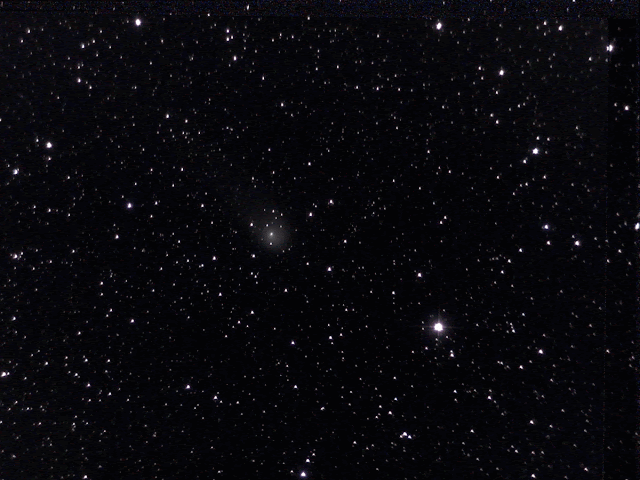Comets are wonderful to observe. I've seen many of them over the years. The first time I ever photographed a comet was on film (Yes, I'm old). I captured comet Halley back in 1986 and comets Hyakutake and Hale-Bopp a decade later.
Probably the next comet I photographed was C/2011 L4 PanSTARRS came around in 2013. Then there was C/2020 F3 NEOWISE which was pretty good. I wasn't blogging in 2020, but I did get some decent shots of it, including this:
 |
| Self Portrait with Comet |
Most comets aren't bright enough to see visually or capture with a DSLR camera, but there usually are several that are within easy reach of a small telescope.
The very first comet observation I made with a Unistellar eVscope was the night of my first light: November 14, 2020 when I caught Comet C/2020 M3 ATLAS.
My settings for the telescope weren't as good as they could have been, but I was happy to catch something that I wouldn't have caught otherwise. The comet's motion in the sky made it look like a blurred streak, but you can see its tail.The following spring a different Comet ATLAS, C/2020 R4, came pretty close to Earth. I photographed it April 28th when it was just half an astronomical unit (~47 million miles) from Earth.
2021 also had a much more spectacular comet: Comet C/2021 A1 Leonard which was visible in our morning skies in late November and early December. It was a wonderful comet to photograph.
Here's an animated gif of Comet Leonard that I took with my eVscope2 on the morning of December 3, 2021:
 |
| 23 minutes of Comet Leonard's motion against the background stars. |
On the morning of December 6, 2021 the comet was just 0.4 astronomical units (37 million miles) from Earth:
The stars in these sorts of images always look a little strange, but I hope you'll agree that comet's tail and coma are more prominent here.
Afterwards Comet Leonard got even better, but that was a sight for observers in the Southern Hemisphere.
So when is our next bright comet coming? No one really knows. According to Visible Comets in the Future our next comet that might reach naked eye brightness is Comet C/2022 E3 ZTF which is expected to be bright enough to see in January and February of next year, though the brightnesses comets are notoriously difficult to predict.
The brightest comet that is currently visible is C/2017 K2 PanSTARRS. Here's an image of it that I took earlier this month:
Comet PanSTARRS should be a little brighter in July when it is closer to Earth and I will be sure to take a look.
%20April%2028.gif)



Love the images and the info . Thank you
ReplyDelete